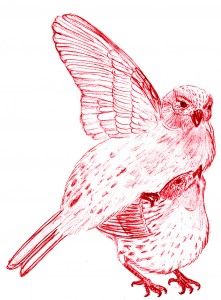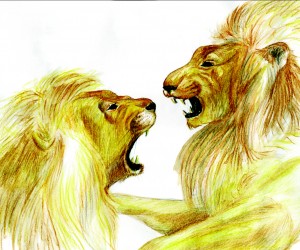MONDAY, 4 JANUARY 2010
When it comes to mating, following the crowd’s way of doing things just won’t pay off if you’re at the back of the queue. For this reason, male mating behaviour is the most ferocious example of evolutionary jostling. Rather than lose out by trying to compete in one specialised way, males have developed an array of strategies that sidestep the competition. As a result, otherwise less attractive males manage to do rather well for themselves.Many male birds and mammals can sire offspring on the sly, even if they fail to court females, by engaging in cuckoldry. Dunnocks, or hedge sparrows, (Prunella modularis) are a well-studied example. If a male does not find a female to nest with, he may discreetly court an attached female when her mate is not looking on. Females are willing to engage in such extra-marital relations because two males will contribute to parenting duties, both thinking that they have fathered the nestlings. However, the females’ official mates are not generally so sanguine about these unorthodox arrangements; they guard females closely and periodically peck at their mate’s cloaca, the opening of the reproductive tract, to make them eject other males’ sperm. That said, attached male dunnocks will also try to father a few extra-marital sprogs if at all possible.
Alternatively, males may be more open in their sharing of females. Rather than risk solitary battle to be the head of a pride, some male lions form small gangs, usually with relatives. This greatly increases their chance of taking over a pride and makes it much less likely that they will be ousted by incoming males. A single male’s tenure in a pride is often only about two years, but groups can remain in place for much longer. Length of tenure is important for reproductive success, since new males habitually kill the cubs already present in a pride so that females are quickly ready to mate again. Even if a male is not the group alpha, it may be well worth sharing the females if he stands a far better chance of getting to mate at all than he would alone.
Other males may not engage in run-of-the-mill courtship at all, but instead ride on the efforts of others. Male field crickets (Gryllus species) broadcast a mating call to attract nearby lady crickets. Unfortunately, this also causes nearby parasitoid wasps to make a beeline for the male in question, with dire consequences. About 14 per cent of cricket males do the sensible thing and keep quiet. To ensure that they do not lose out in the mating stakes, however, they situate themselves close to singing males, who are risking attack by the parasitoids. For the lurking males, this lowers the chance of being attacked, but means that they are on hand to entertain any females who like what they hear.
In carpenter frogs (Rana virgatipes), some males use this trick to appear more attractive. Males call to display their general machismo – the pitch and volume of their call reflects their size. Smaller males, rather than singing in vain amongst more well-endowed competitors, locate themselves close to large-sounding males, ready to pounce on any enticed females.
Environmental circumstances force some males to try an alternative tack. Male Orthophagous dung beetles usually have large horns with which they fight other males and diligently guard nest burrows while females see to domestic tasks like laying eggs. If, however, a male does not manage to attain sufficient body size during growth, due to environmental factors, these horns don’t form. He becomes a ‘sneaker male’, unable to fight other males but instead able to burrow behind guarding males and secretly mate with their females. Sneaker males also have bigger testes, so may be very fertile. It seems that they are cutting their losses – there is little to gain from being a small-horned male, so they might as well direct their resources to more fruitful endeavours.
In other cases, a strategic re-think can be rather more drastic. Most species of coral-reef fish, such as spectacled parrotfish (Scaridae species), change sex through the course of their lives. This change in both behaviour and physiology can happen surprisingly rapidly over a matter of days. As a male becomes older and larger, the best way to maximise his reproductive success may be to become a female, since larger females are more fecund and produce more eggs. This could be especially effective if there is a high proportion of males around.
Often, several mating strategies may be equally successful. In many species, this results in the persistence of several genetically distinct types of males. Populations of male pygmy sword-tailed fish (Xipophorus species) contain several different versions of a particular gene that affects growth rates. Different males therefore have different growth patterns. Some mature early but have diminutive frames, others grow slowly but mature into the females’ idea of hot stuff. To make up for slight stature, the small males aggressively chase females rather than courting them. Large males needn’t try too hard because they are inherently more attractive. However, larger males also have higher mortality, so have shorter breeding lives. This means that both male types have similar reproductive success, so both sets of genes are maintained in the population.
In species with genetically distinct male morphs, the smaller morph often mimics a female. This is frequently found in species of fish in which males brood the eggs after fertilisation. In round gobies (Neogobius melanostrobius), normal males are up to ten inches long and attract females with steroid signals and visual displays. After a female has deposited her eggs in the male’s shallow nest, he fertilises and guards them until they hatch. Small-morph males are the size and appearance of females and use their feminine charms to beguile larger males into allowing them around their nests when a female is laying. Once she is finished, the small male nips in, fertilises the brooding male’s hard-won eggs and scarpers.
The persistence of more than two male types can also occur through cycles in sexual selection. Side-blotched lizards (Uta stansburiana) have three male morphs. Amongst females, the flavour of the month is generally the least common male. One year, ‘ultra dominant’ orange males may be all the rage. The next year, when orange males are the most common as a result of the previous year’s breeding success, yellow-throated sneaker males manage to get the most matings. The sneakers are in turn defeated by blue-throated males who have modest mating ambitions and carefully guard a few females. However, blue males are inevitably superseded by aggressive orange males with large territories, and so the cycle continues.
This variety of mating strategies demonstrates that sexual selection is one of the most potent forces behind evolutionary change. Otherwise unsuccessful males must metaphorically think outside the box if they are to get a bigger slice of the reproductive pie. Evolution has produced strategies that allow the underdogs to avoid competing on the same terms as the alphas. These range from alternative behaviours and developmental pathways to genetically distinct male morphs. Such variation in tactics gives each individual a chance to win the most desirable of all prizes – the chance to fertilise some eggs.
Natalie Lawrence is a second year Natural Sciences Tripos student




